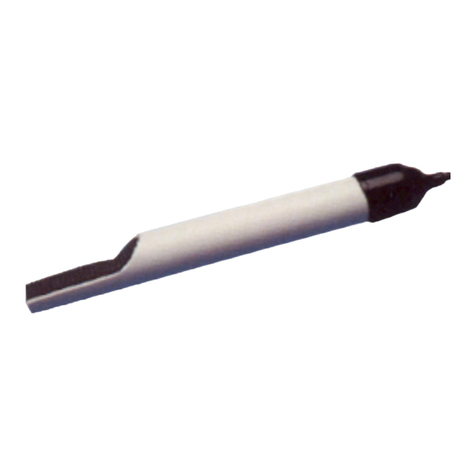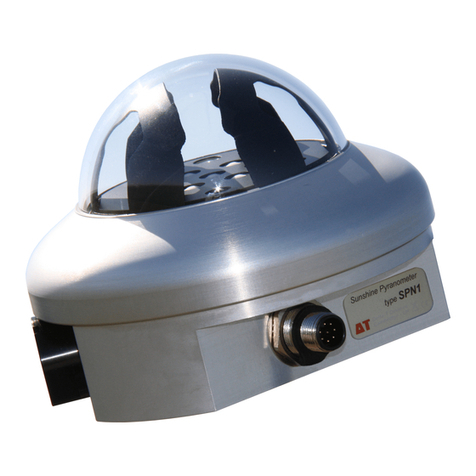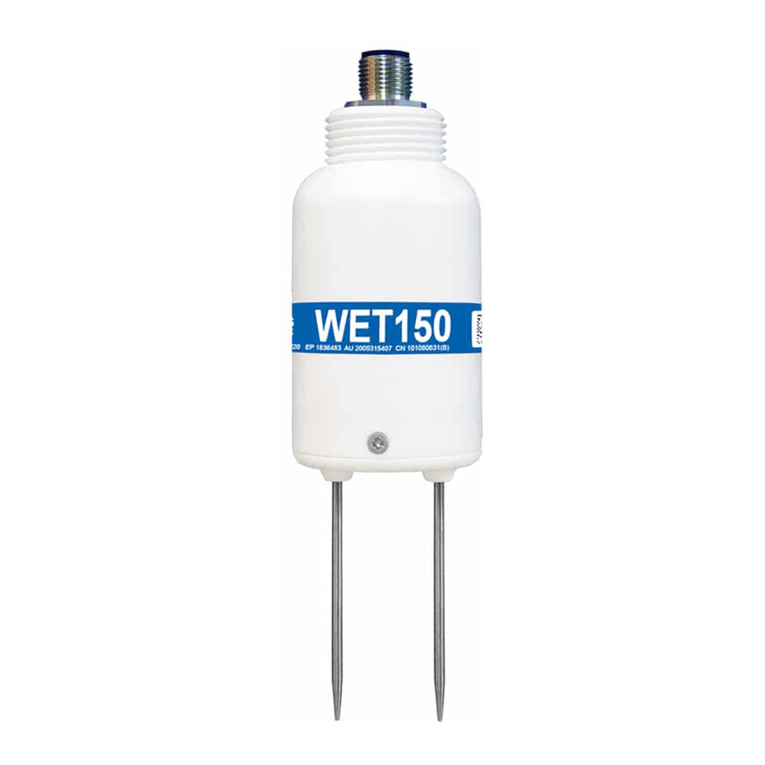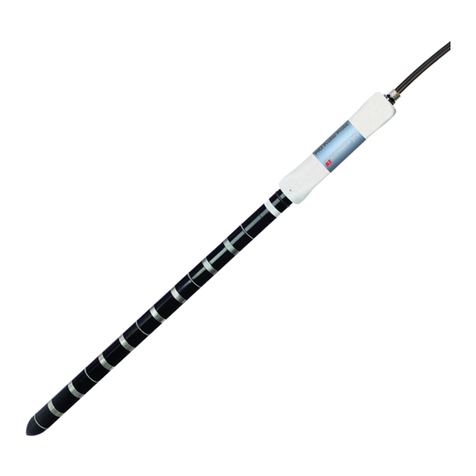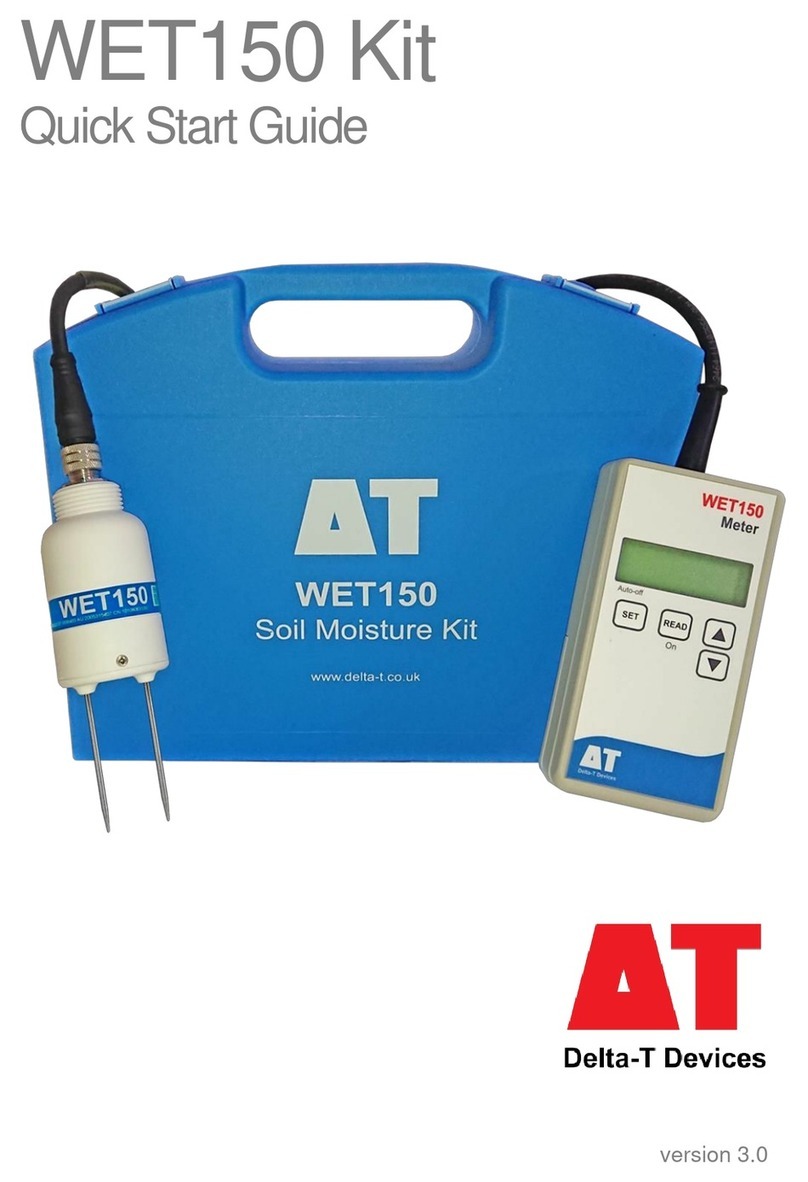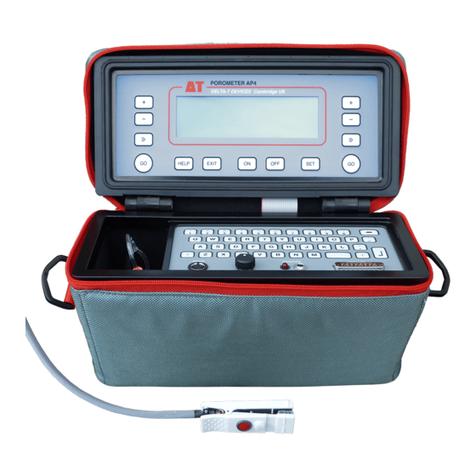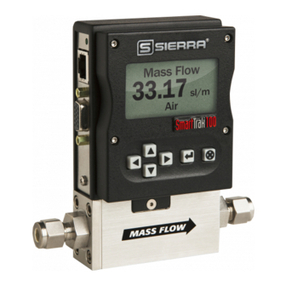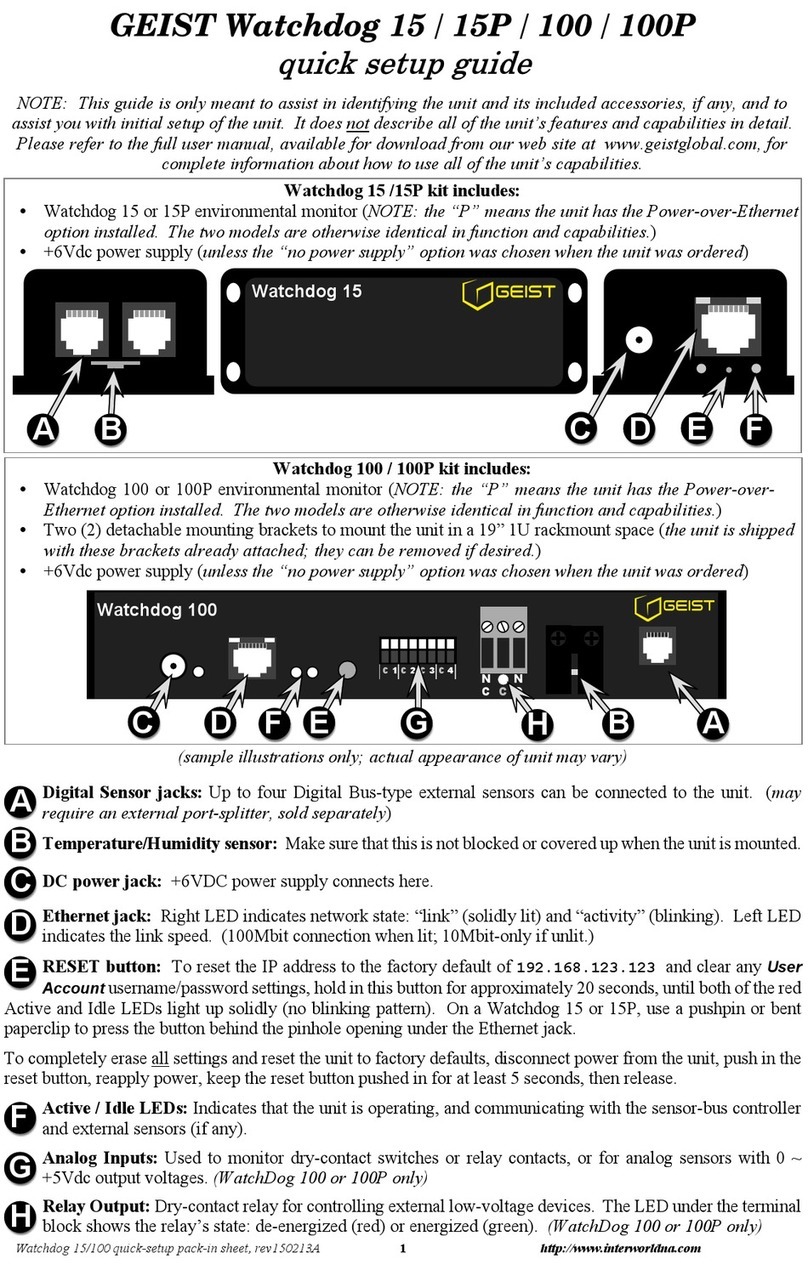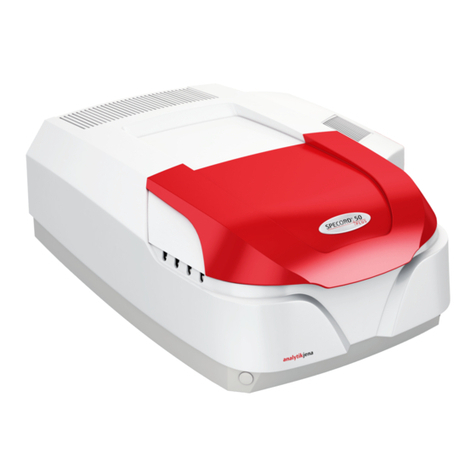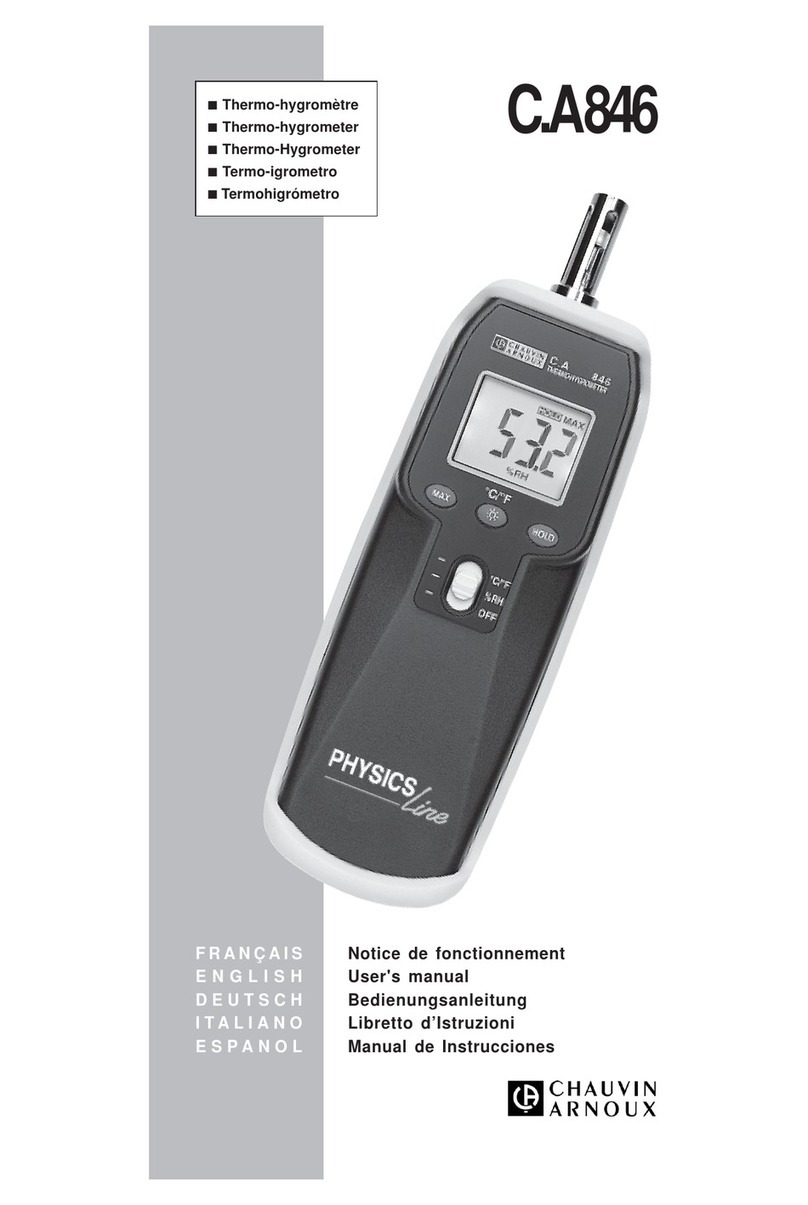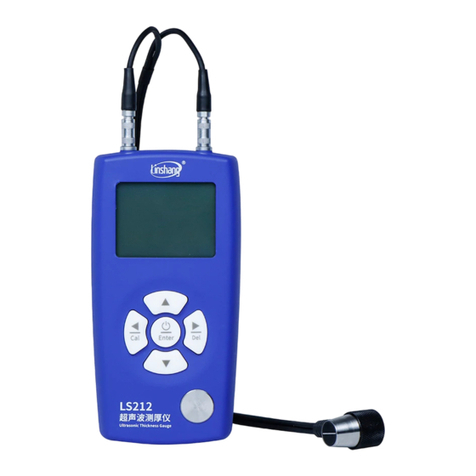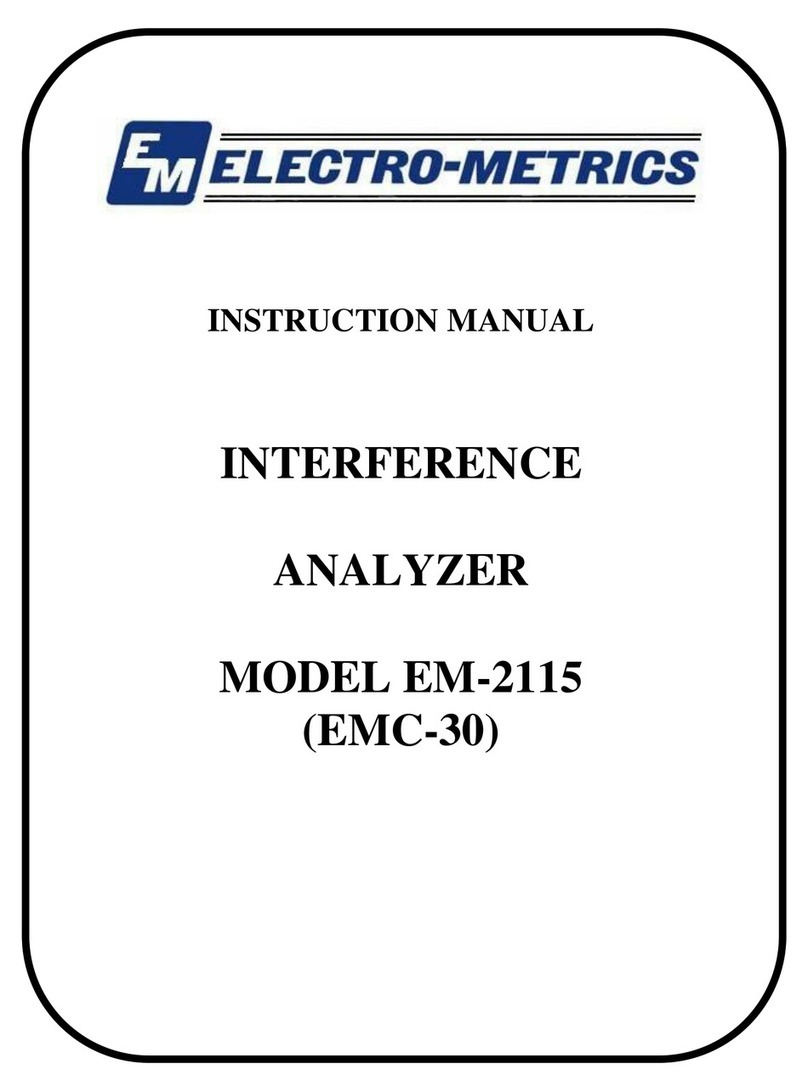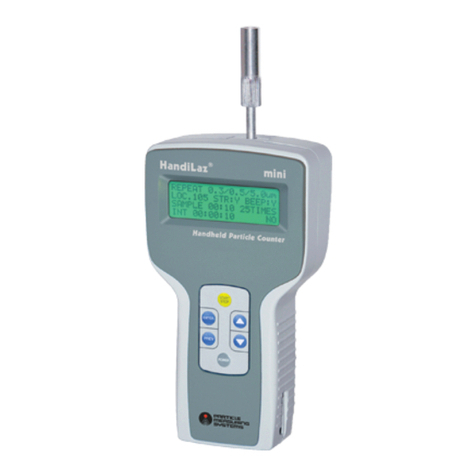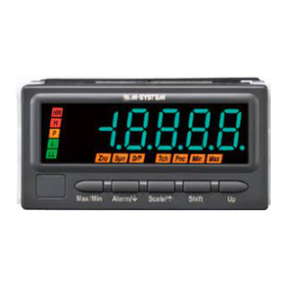Delta-T Devices SWT5 User manual

User Manual for the
Tensiometer
types SWT5 & SWT5x
Delta-T Devices Ltd
SWT5-UM-2

2/49
Notices
Copyright
All rights reserved. Under the copyright laws, this manual
may not be copied, in whole or in part, without the written
consent of Delta-T Devices Ltd. and UMS GmbH. Under
the law, copying includes translation into another language.
Copyright © 2009 Delta-T Devices Limited
© 2009 UMS GmbH
CE conformity
The sensors described in this document are CE marked by
the manufacturer.
Design changes
Delta-T Devices Ltd reserves the right to change the
designs and specifications of its products at any time
without prior notice.
SWT5 User Manual, Version 2 Oct 2009
Delta-T Devices Ltd
Tel: +44 1638 742922
130 Low Road, Burwell
Fax: +44 1638 743155
CAMBRIDGE CB25 0EJ
e-mail: [email protected]
U.K.
web: http://www.delta-t.co.uk
Within the EU: disposal through
municipal waste prohibited - return
electronic parts to your local distributor

3/49
Table of contents
User Manual for the 1
Tensiometer 1
Notices 2
Introduction 5
1.1 Safety instructions and warnings 5
1.2 Unpacking 6
1.3 Foreword 7
1.4 Guarantee 7
1.5 Durability 7
1.6 SWT5 and SWT5x 8
1.6.1 Soils and soil water 8
1.6.2 Intended use 8
1.6.3 Typical applications 9
1.6.4 Extended measuring range of the SWT5x 9
1.6.5 Specific notes 10
1.7 Quick start 11
2Sensor Description 13
2.1 Parts 13
2.1.1 Body and shaft 13
2.1.2 Pressure sensor 13
2.1.3 Reference air pressure 13
2.1.4 The ceramic tip 14
2.2 Analog output signals 14
3Installation 15
3.1 Advance planning 15
3.1.1 Selecting the measuring site 15
3.1.2 Number of Tensiometers per level 15
3.1.3 Extent of the site 15
3.1.4 Ideal conditions for installation 16
3.1.5 Documentation 16
3.1.6 Selecting the installation angle 16
3.2 Installation procedure 17
3.3 Offset correction for non horizontal installations 18
3.4 Connecting SWT5 and SWT5x 19
3.4.1 Spot readings with the SWT-MR (Infield7) 19
3.4.2 Cables 19
3.4.3 General requirements 19
3.4.4 Connection to a data logger 20
3.4.5 TVB1 and TVB-M Tensiometer power supplies 20
3.4.6 Delta-T Tensiometer loggers 21
4Service and maintenance 22
4.1 Refilling 22
4.1.1 When do Tensiometers need to be refilled? 22

4/49
4.1.2 Refilling SWT5 in lab and field 23
4.2 Testing 34
4.2.1 Calibration 34
4.2.2 Check the Offset 34
Cleaning 35
Storage 35
5Protecting the measuring site 35
5.1 Theft and vandalism 35
5.2 Cable protection 35
5.3 Frost 35
6Useful notes 36
6.1 Maximum measuring range and data interpretation 36
6.2 Temperature influences 38
6.3 Vapor pressure influence 38
6.4 Osmotic effect 38
7Troubleshooting 38
8Appendix 39
8.1 Technical specifications 39
8.2 Wiring configuration 40
8.3 Accessories 41
8.3.1 Connecting and extension cables 41
8.3.2 Handheld measuring device 42
8.3.3 Tensiometer loggers 43
8.3.4 Voltage regulators 44
8.3.5 SWT5-FRK2 44
8.4 Units for soil water and matrix potentials 45
9Technical Support 46
9.1 Terms and Conditions of sale 46
9.2 Service and Spares 47
9.3 Technical Support 47
Contact Details 47
10 Index 48

SWT5 User Manual v2 Introduction 5
Introduction
1.1 Safety instructions and warnings
Electrical installations must comply with the safety and EMC
requirements of the country in which the system is to be used.
Please note that any damage caused by handling errors are out of our
control and therefore are not covered by guarantee.
Tensiometers are instruments for measuring the soil water tension, and
soil water pressure and are designed for this purpose only.
Please pay attention to the following possible causes of risk:
Lightning: Long cables act as antennas and might conduct surge
voltage in case of lightning stroke –this might damage sensors
and instruments.
Frost: Tensiometers are filled with water and therefore are
sensitive to frost! Protect Tensiometers from frost at any time.
Never leave Tensiometers over night inside a cabin or car when
freezing temperatures might occur!
Tensiometers normally are not damaged when the cup is installed
in a frost free soil horizon.
Excess pressure: The maximum non destructive pressure is
300 kPa = 3 bar = 3000 hPa. Higher pressures - which might
occur, for example, during insertion in wet clayey soils, whilst
measuring shear force, or during refilling and reassembling - will
destroy the pressure sensor!
Electronic installation: Any electrical installations should only be
done by qualified personnel.
Ceramic cup: Do not touch the cup with your fingers. Grease,
sweat or soap residues will influence the ceramic's hydrophilic
performance.
Do not twist the SWT5 shaft against the sensor body!

SWT5 User Manual v2 Introduction 7
1.3 Foreword
Measuring systems must be reliable and durable and should require a
minimum of maintenance to achieve target-oriented results and keep
the servicing low. Moreover, the success of any technical system is
directly depending on it being used correctly.
At the beginning of a measuring task or research project the target, all
effective values and the surrounding conditions must be defined. This
leads to the demands for the scientific and technical project
management which describes all quality related processes and decides
on the methods to be used, the technical and measurement tools, the
verification of the results and the modeling.
The continuously optimized correlation of all segments and its quality
assurance are finally decisive for the success of a project.
We wish you good success with your projects. Please do not hesitate
to contact us for further support and information.
1.4 Guarantee
See Terms and Conditions of Sale on page 46.
1.5 Durability
The nominal lifespan for outdoor usage is 10 years, but protection
against UV-radiation and frost as well as proper and careful usage
substantially extends the lifespan.

8 Introduction SWT5 User Manual v2
1.6 SWT5 and SWT5x
1.6.1 Soils and soil water
All water movement in soil is directly dependant on the soil water
tension, because water, both in soils and on the surface, will will move
from a point of higher potential to a point of lower potential.
The majority of soil water flows take place in response to small water
tensions. Only Tensiometers allow the direct and precise measurement
of these small tensions.
Natural soils in the ground are heterogeneous. It is not just
precipitation and evaporation that matter, but also the soil texture,
particle size distribution, cracks, compaction, roots and cavities. All
these heterogeneities cause the soil water tension to vary. It is prudent
therefore to have multiple measuring points, particularly in soil
horizons close to the surface.
1.6.2 Intended use
Tensiometers measure soil water tension –a measure of the soil
matrix potential –which is the work the plant needs to do in order to
extract water from a unit volume of the soil. These Tensiometers work
from +100 kPa (water pressure/level) to -85 kPa (suction / soil water
tension). The SWT5x operates to even lower tensions.
If the soil gets drier than -85 kPa, the Tensiometer runs dry and must
be refilled as soon as the soil is sufficiently moist again (see Fig 6.1).
Soil water and Tensiometer water have contact through the ceramic
which is porous and permeable to water. A wetted porous ceramic
creates an ideal pore/water interface. The soil water tension is directly
conducted to the pressure transducer which offers a continuous signal.
The atmospheric reference pressure is provided through a membrane
on the cable, a unique patented method.
The SWT5 Miniature Tensiometer is specially designed for point
measurements, e. g. in soil columns, pots or laboratory lysimeters, or
when the measurement of a minimal span is desired.
With an active surface of only 0.5 cm2and a diameter of 5 mm the
ceramic tip has all advantages of small dimensions: little soil
disturbance, point measurement and fast response.

SWT5 User Manual v2 Introduction 9
1.6.3 Typical applications
Typical applications of the SWT5 and SWT5x:
Point measurements of water potential
Miniature soil column studies, e. g. in combination with micro
water samplers and soil temperature probes
Determination of drying curves of water content vs tension, or
water conductivity vs tension (pF/wc and K/Psi) in soil
columns, soil cores or soil sampling rings
Determination of leachate and capillary water movements
Controlling irrigation
Pot experiments
Measurements in the upper soil horizons in the field
Monitoring with data loggers
Spot readings with the SWT-MR (INFIELD7)
For field applications it might be better to use SWT4 or SWT4R
Tensiometers.
1.6.4 Extended measuring range of the SWT5x
The special version SWT5x is tested to reach a measuring range of
-160 kPa (-1600 hPa) when delivered. To achieve this, the SWT5x
requires an absolutely bubble-free filling.
You might notice that your SWT5x might even go down to -250 kPa
before running empty, sometimes even to -450 kPa, but this is an
exception and cannot be guaranteed.
The SWT5x is identical with the SWT5 but has a different ceramic. The
extended measuring range is made possible by an effect called boiling
retardation, which requires a special ceramic with smaller pores and an
absolutely gas-free filling process.
Do not allow the SWT5x ceramic to dry out by leaving it unprotected
in air: by drying out the tension might reach the destructive pressure.
Due to the finer pores of the ceramic the water conductivity is lower.
Therefore the response of a SWT5x is slower than with a standard
SWT5.
When the shaft is touched it might warm up. This might cause a
temporary change of the pressure.

10 Introduction SWT5 User Manual v2
1.6.5 Specific notes
SWT5 and SWT5x are not suitable for dry soils and they are not
frost resistant.
When installed in the field provide sufficient protection.
The less air that is inside the cup, and the better the soil's
conductivity is, the faster the Tensiometer will respond to tension
changes.
It does not make sense to refill a Tensiometer while the soil is dryer
than -90 kPa (-900 hPa) for the SWT5 or - 160 kPa ( -1600 hPa)
for the SWT5x.
The use of a quartz clay slurry is only recommended in clayey soils
and only if the drilled diameter is larger than the shaft diameter (5
mm). In coarse sand or gravel soil a fine grained slurry paste would
act as a water reservoir which would lead to a slower response.
The SWT5 can be installed in any position and orientation. Bubbles
are easily detectable through the transparent shaft.
Output signals are standardized.

SWT5 User Manual v2 Introduction 11
1.7 Quick start
This is only a summary of following chapters. Please read the complete
manual carefully before using the instrument!
SWT5 tensiometers are filled and degassed when supplied and are
ready for installation. The procedure is the same for SWT5 and
SWT5x.
In very soft soils the SWT5 can be inserted directly without drilling a
hole. As the shaft is fragile, no force should be applied.
For hard soils a special auger kit for is available in the SWT5-FRK2
field refill kit,
When the SWT5 auger is used, slurrying is unnecessary.
Installation procedure:
1. Drill a hole with the required diameter and depth.
Mark the installation depth on both auger and SWT5 shaft.
2. Connect the SWT5 to a readout device, for example a data logger
for continuous measurements or the SWT-MR (INFIELD7) handheld
device for spot readings.
During the installation the Tensiometer reading must be controlled
all the time. Especially in wet, clayey soils a high pressure might
develop while inserting the SWT5.
Avoid pressures of over 2 bar (200kPa, 2000 hPa).
Note: 3 bar will destroy the pressure transducer. If necessary stop or
slow down the insertion to allow the pressure to decrease.
3. Carefully remove the water-filled rubber bulb from the tip and gently
and steadily insert the SWT5 down to the mark.
Never turn the SWT5 inside the borehole as this might loosen the
shaft.
Put the protective cover on the plug whenever the plug is not
connected. Dirt will reduce the water tightness of the plug.
Remember to put the protective cover back on the plug after taking
spot readings with the SWT-MR (INFIELD7).

12 Introduction SWT5 User Manual v2
Sealed cable
The SWT5 can be completely
buried. Protect buried cables
Don’t immerse white membrane.
High grade porous ceramic cup
Filled with degassed water.
wassergefüllt, mit Befüllröhrchen.
Acrylic glass shaft
Shafts are available with
lengths from 2 to 20 cm
Sensor body
The incorporated piezoelectric
pressure sensor measures the
soil water tension against
atmospheric pressure.
Reference air pressure
The reference atmospheric air
pressure is conducted to the
pressure transducer via the air
permeable (white) Teflon
membrane and through the
cable.

SWT5 User Manual v2 Sensor Description 13
2 Sensor Description
2.1 Parts
2.1.1 Body and shaft
The sensor body is made of transparent acrylic plastic and
incorporates the pressure transducer and all electronic parts. The body
is backfilled with resin to hermetically seal the electronics and make
the body watertight.
2.1.2 Pressure sensor
The piezoelectric pressure sensor measures the soil water tension
against the atmospheric pressure. Atmospheric pressure is conducted
via a white air-permeable membrane on the cable, through the cable,
to the reference side of the pressure sensor.
The maximum permissible, i.e. non-destructive, pressure is 3 bar
(300 kPa, 3000 hPa). Higher pressure will damage the sensor and
absolutely must be avoided! High pressures can appear for example
when cup and sensor are reassembled, when inserted in wet, clayey
soils, or in tri-axial vessels used for measuring shear forces.
2.1.3 Reference air pressure
The reference atmospheric air pressure is conducted to the pressure
transducer via the air permeable (white) Teflon membrane in-line in
the cable. The membrane does not absorb water. Water will not pass
through the membrane into the cable, but condensed water inside the
cable can leave the cable through the membrane.
The white membrane on the cable must always be in contact with air
during a measurement and should never be submersed under
water.

14 Sensor Description SWT5 User Manual v2
2.1.4 The ceramic tip
To transfer the soil water tension as a negative pressure into the
Tensiometer, a semi-permeable barrier is required. This must have
good mechanical stability, be permeable to water and impermeable to
gas (when wet).
The Tensiometer cup consists of a ceramic, sintered Al2O3. A special
manufacturing process guarantees homogeneous porosity with good
water conductivity and very high hardness. Compared to conventional
porous ceramic the cup is much more durable.
The bubble point of a SWT5 cup is about 200 kPa (20 bar, 2,000 hPa),
and for a SWT5x it is about 500 kPa (50 bar, 5,000 hPa).
If the soil gets dryer than these values, air can enter, the negative
pressure inside the cup decreases, and the readings go down to 0 kPa.
With these characteristics this material has outstanding suitability to
work as the semi permeable diaphragm for Tensiometers.
Ceramic cup: Do not touch the cup with your fingers. Grease, sweat
or soap residues will influence the ceramic's hydrophilic
performance.
Do not allow the SWT5 ceramic to dry out by leaving it unprotected
in air: By drying out the bubble point might be reached, the reading
will go to 0 kPa and air can enter the cup, which will then require
refilling.
2.2 Analog output signals
The pressure transducer offers the soil water tension as a linear output
signal, with 1 mV corresponding to 1 kPa (10 hPa).
As the pressure transducer is a Wheatstone full bridge, it has to be
connected correctly.
See also Connecting SWT5 and SWT5x on page 19.
Please also read the user manual for your display unit or data-logger
before connection.

SWT5 User Manual v2 Installation 15
3 Installation
3.1 Advance planning
3.1.1 Selecting the measuring site
The installation spot should be representative of the soil horizon! In
heterogeneous soils, several soil samples should be taken and
classified before or during installation. If the column is refilled care
should be taken to achieve the best possible homogenous distribution
and uniform compaction. Bear in mind a possible shrinking of backfilled
columns when SWT5s are installed.
On tillage sites (with plants) root spreading and growth during the
measuring period should be considered. Fine roots might develop
around the ceramic cup as it is a poor but assured water source. Avoid
the root zone if possible or relocate the Tensiometer from time to time.
3.1.2 Number of Tensiometers per level
The lower the level the less the variations of water potentials are. In
lower sandy or pebbly horizons one Tensiometer per depth is
sufficient. Close to the surface about 3 Tensiometers per level are
recommended.
Guiding principle: More heterogeneous sites and soil structures
require a higher number of Tensiometers.
3.1.3 Extent of the site
A large number of well-spaced samples will help reduce sampling
errors in heterogeneous soils.
To obtain a differential description of the soil water situation at least 2
Tensiometers are recommended per horizon, one in the upper and one
in the lower level.
The maximum recommendable cable lengths for SWT5 and SWT5x
are 20 meters.
Accuracy: long cables cause a reduction of the accuracy.
Lightning: cables act as antennas and should always be as short
as possible.

16 Installation SWT5 User Manual v2
3.1.4 Ideal conditions for installation
For the installation of Tensiometers, the ideal conditions are:
Frost-free soil.
Wet coarse clay or loess.
Low gravel content.
3.1.5 Documentation
For every measuring spot you should:
Measure out the position where the pressure sensor will be placed.
(A must for installations below the ground surface).
Take documenting photos before, during and after installation.
Save a soil sample.
Write down installation depth and angle with each sensor
identification (serial number).
Mark all connecting cables with the corresponding sensor
identification, serial number or logger channel on each end.
Clip-on numbered rings, available as an accessory.
3.1.6 Selecting the installation angle
An installation position would be ideal if the typical water flow is not
disturbed by the Tensiometer. No preferential water flow along the
shaft should be created.
If the ceramic cup is positioned higher than the sensor body the first
bubble that appears inside the shaft will block the water exchange and
stop the Tensiometer working.

SWT5 User Manual v2 Installation 17
3.2 Installation procedure
The following tools are required for installation in the field:
An auger with diameter 5 mm, preferably the Tensiometer
auger provided in the SWT5-FRK2 field refill kit.
Rule, spirit level, angle gauge, marker pen
Note book and camera for documentation of site and soil
profile
Perhaps PE-plastic bags for taking soil samples from the site
1. Drill a hole with the required diameter and depth. Mark the
installation depth on both auger and SWT5 shaft.
2. If the hole’s diameter is larger than 5 mm mix a slurry of water and
ground-up soil material.
3. Connect the SWT5 to a readout device, for example a data logger
for continuous measurements or the SWT-MR (INFIELD7)
handheld device for spot readings.
During the installation the Tensiometer reading has to be controlled
all the time. Especially in wet, clayey soils a high pressure might
develop while inserting the SWT5. A pressure of over 2 bar will
destroy the pressure transducer. Stop or slow down the insertion to
allow the pressure to be relieved.
4. If you use a slurry paste pour it into the hole.
5. Pull off the water filled rubber cap from the shaft. Do not turn the
cap as this might unscrew the shaft.
6. Gently and steadily insert the SWT5 down to the mark while
checking the reading.
Never turn the SWT5 inside the borehole as this might loosen the
shaft.
The less air there is inside the cup, and the better the soil's hydraulic
conductivity is, the faster the Tensiometer will respond to tension
changes.
7. Put the protective cover on the plug whenever the plug is not
connected. Dirt will reduce the water tightness of the plug.
Remember to put the protective cover back on the plug after taking
spot readings with the SWT-MR (INFIELD7).

18 Installation SWT5 User Manual v2
8. Connect the signal cables as described in the chapter "Connecting
the SWT5 or SWT5x" on page 19.
9. Write down the serial number, position, installation angle and
depth.
10. Protect the cables against rodent damage. Lead the cables
through plastic pipes or protective cable trunking.
3.3 Offset correction for non horizontal installations
The pressure transducer is calibrated without a
cup. Thus, no compensation is required for
horizontal installations.
If a SWT5 or SWT5x is installed in a non
horizontal position, the vertical water column
draws on the pressure sensor and causes an
offset shift.
Compensate the offset:
by calculation,
by entering the installation angle in the SWT-MR (Infield7) for spot
readings,
in the configuration of a data logger by setting an offset.
The deviation is largest for a vertical water column (at 0o). The water
column drawing on the pressure transducer is equal to the shaft length,
ranging from 2 to 20 cm. The offset is shifted for 0.1 kPa per cm shaft
length.
Example: A 5 cm vertical column of water below the pressure sensor
will create an 0.5 kPa offset. This means that when the soil water
tension is 0 kPa the sensor will indicate -0.5 kPa.
3 mm
Centre of pressure transducer
Centre of ceramic

SWT5 User Manual v2 Installation 19
Table showing the offset correction when a 5 cm column of water is
tilted at various angles:
Angle to vertical line
0°
10°
15°
20°
25°
30°
Offset correction in [kPa]
+0.5
+0.49
+0.48
+0.47
+0.45
+0.43
Angle to vertical line
45°
60°
70°
75°
80°
90°
Offset correction in [kPa]
+0.35
+0.25
+1.7
+1.3
+0.9
0
The offset is entered as + in your logger if you regard the soil water
tension to be negative (0 ... -85 kPa).
3.4 Connecting SWT5 and SWT5x
3.4.1 Spot readings with the SWT-MR (Infield7)
SWT5 and SWT5x are fitted with a 4-pin plug. The plug can be
connected directly to the handheld measuring device for taking spot
readings of the soil water tension. This displays and stores the soil
water tension readings.
Stored readings can be downloaded with the USB adapter and
Windows PC software SWT-MR-USB, available as accessory.
Remember to put the protective cover back on the plug after taking
spot readings with the SWT-MR.
3.4.2 Cables
Connecting and extension cables are required for connecting SWT5
and SWT5x to a data logger or other data acquisition device. Find
cables in the chapter “Accessories”.
Cover plugs with the supplied protective cover if not connected.
3.4.3 General requirements
The pressure transducer is a non-amplified bridge circuit which is
calibrated for 10.6 VDC and requires a stabilized power supply.
Other supply voltages are possible, but the output signal range has to
be recalculated.

20 Installation SWT5 User Manual v2
In a full-bridge the signal must be measured differentially. This means
do not measure only signal plus against common ground, but measure
the voltage drop between signal minus against common ground and
signal plus against common ground.
The supply voltage has to be constant and stabilized.
The supply voltage must not exceed 18 VDC.
If the Tensiometer is not permanently powered the warm-up before
a measurement should be no greater than 10 seconds. The 99%
value is reached in 0.01 seconds, so a 1 s warm up is fine.
If the Tensiometer is supplied with 10.6 VDC the output signal range
is around 5.3 VDC. A data logger must have the capability to
measure such a signal level, but many loggers cannot do this.
In such cases use a TV batt (type TVB1 or TVB-M) power supply.
3.4.4 Connection to a data logger
The pressure transducer is a non-amplified bridge circuit which is
calibrated for 10.6 VDC and requires a stabilized power supply.
Some logger types can measure bridge circuits directly, other loggers
require certain measures as the signal minus and the supply minus do
not have the same ground.
When supplied with just 10.6 V (supply minus = 0 V and supply plus =
10.6 V) the output signal range is between +3.2 V (min.) and +6.8 V
(max.) related to power supply minus.
Other supply voltages are possible, but the output signal range has to
be recalculated.
3.4.5 TVB1 and TVB-M Tensiometer power supplies
These power supplies are designed for Tensiometers SWT3, SWT4,
SWT4R and SWT5. They offers a stabilized 10,6 V power supply,
supplying -5 V and +5,6 V for powering up to 30 tensiometers.
These provide tensiometer output signals of <1V, which is suitable for
many loggers,
The TVB1 fits inside a DL2e logger terminal compartment.
The TVB-M module has no environmental protection and can fit into
an M-ENCL enclosure, and requires 7.5 –16.0 V DC.
This manual suits for next models
1
Table of contents
Other Delta-T Devices Measuring Instrument manuals
Popular Measuring Instrument manuals by other brands
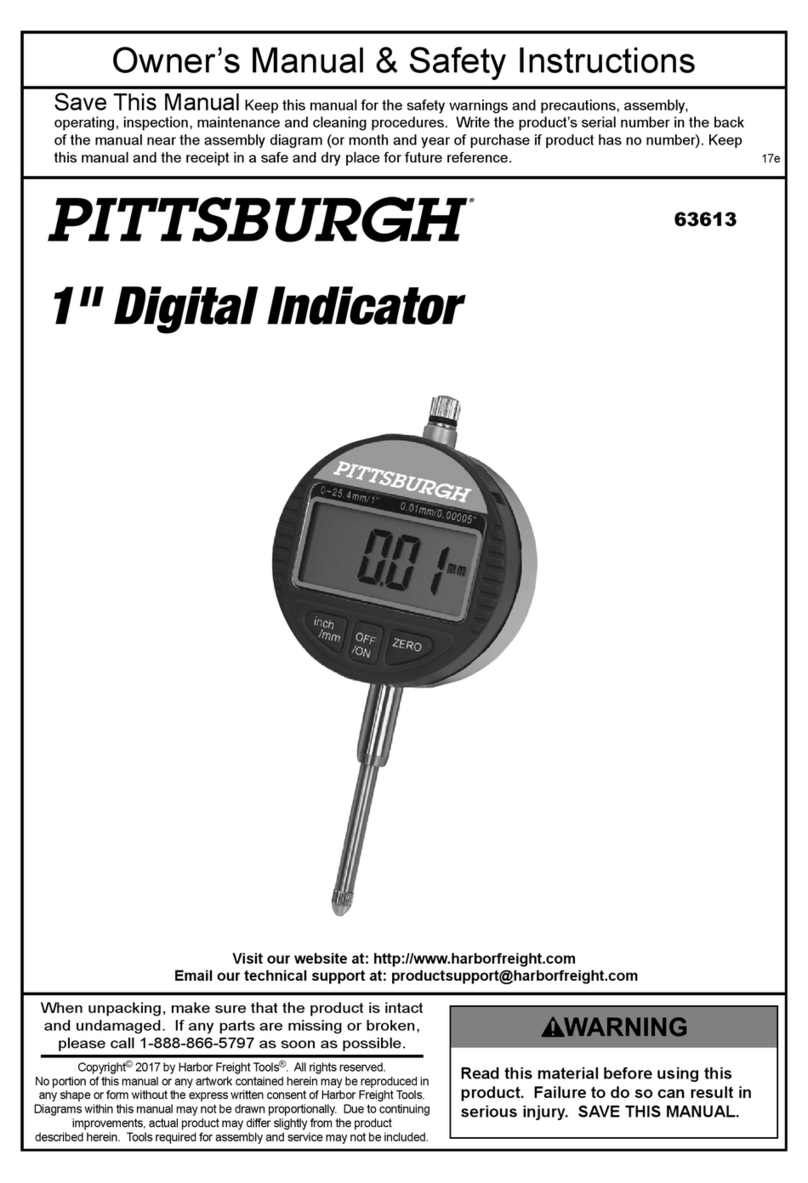
Pittsburgh
Pittsburgh 63613 Owner's manual & safety instructions

Johnson Controls
Johnson Controls EM-1000 Series quick start guide
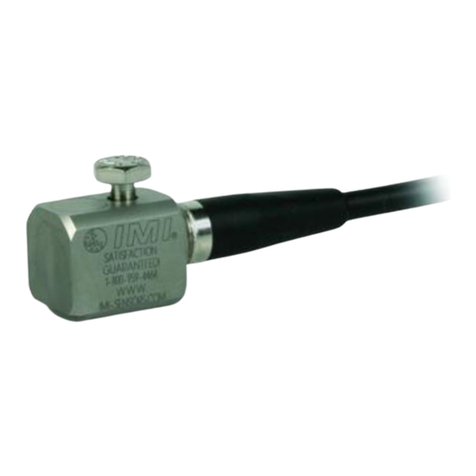
PCB Piezotronics
PCB Piezotronics ICP 602D11 operating guide
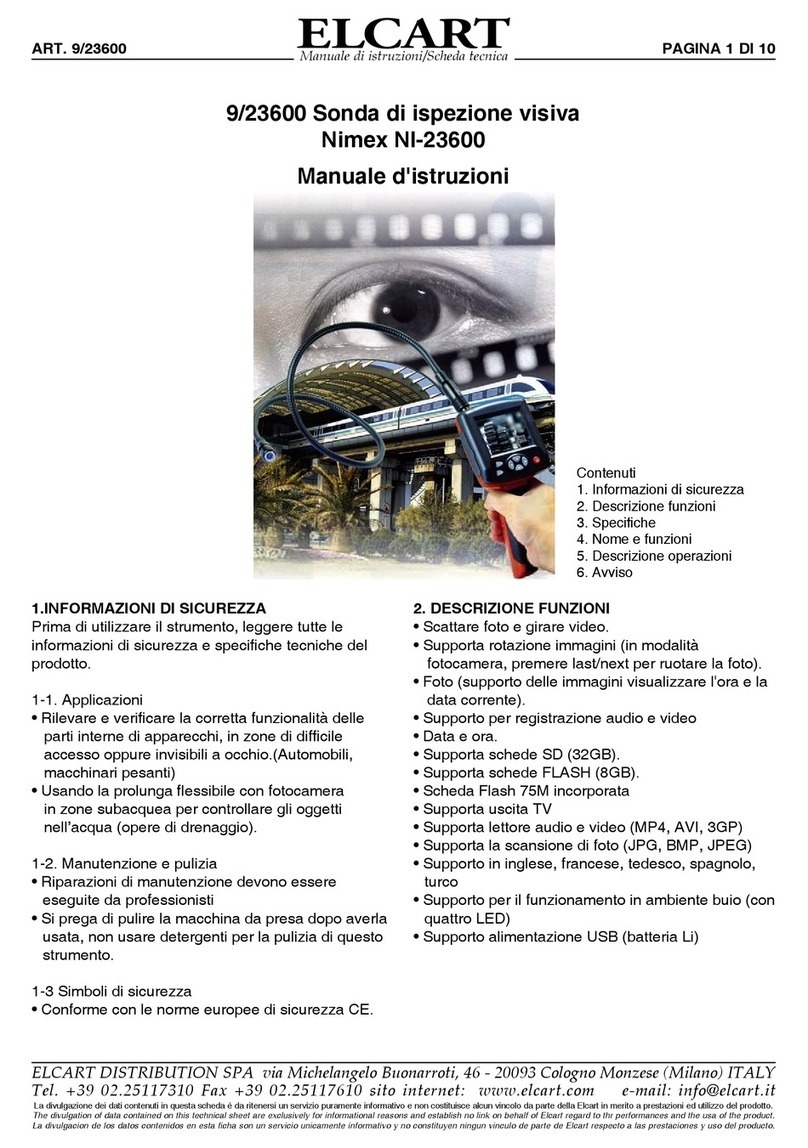
ELCART
ELCART NI-23600 instruction manual
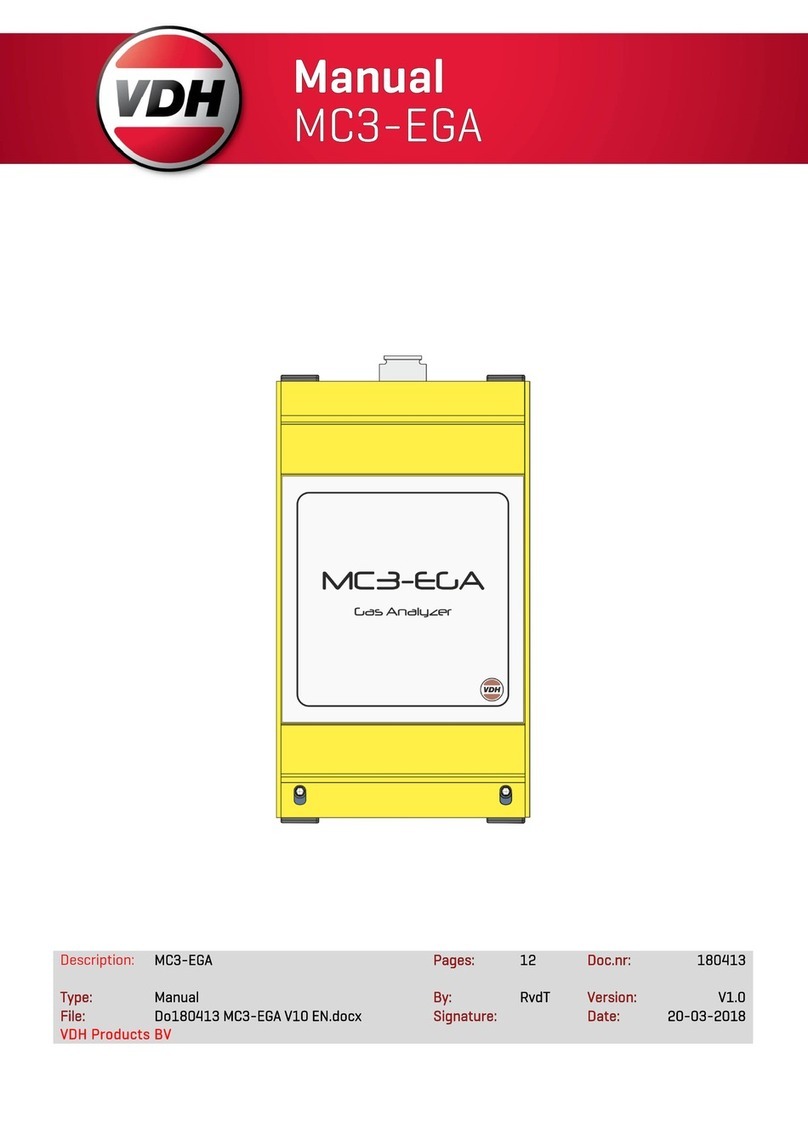
VDH
VDH MC3-EGA manual

Lutron Electronics
Lutron Electronics MMA-386SD Operation manual

